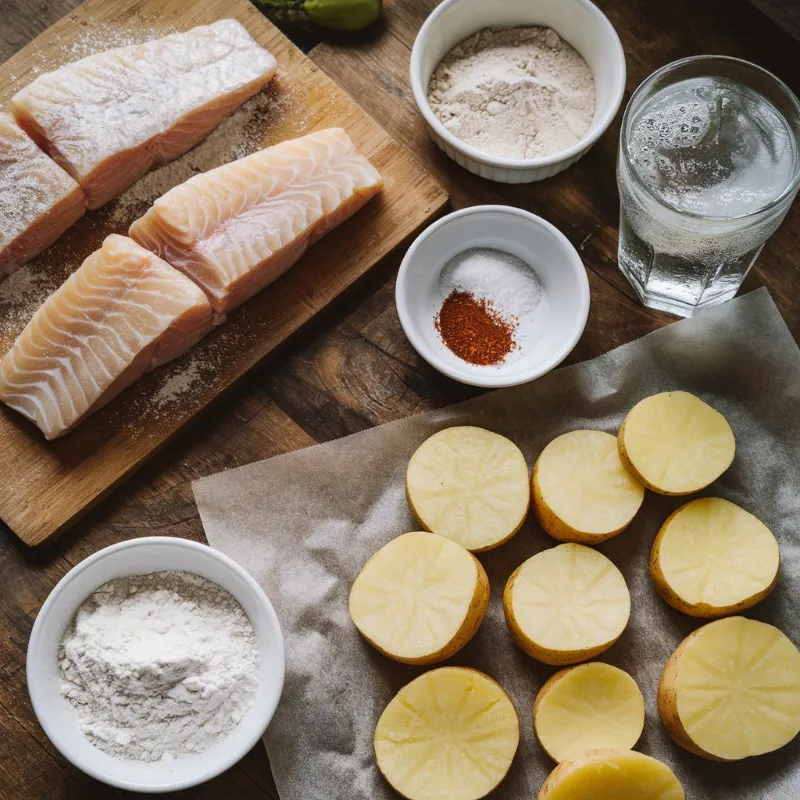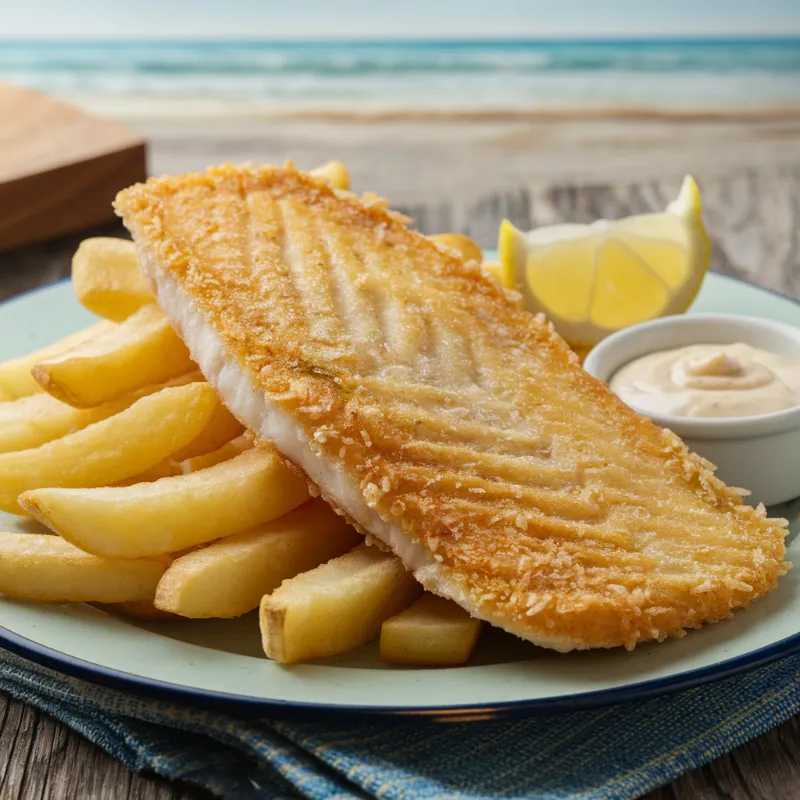There’s something magical about strolling along the seaside, the salty breeze in your hair, and the unmistakable aroma of freshly fried fish chips wafting from a nearby restaurant. For many, it’s a cherished memory of British summers. But for those with dietary restrictions, enjoying this iconic dish hasn’t always been easy.
Traditionally, fish chips are coated in a wheat batter, making them off-limits for coeliacs or anyone avoiding gluten. However, times have changed. Many chip shops and restaurants now offer dedicated gluten free options, ensuring everyone can savour this classic meal.
From East London’s historic roots to modern menus across the UK, the dish has evolved. Strict protocols and dedicated fryers help avoid cross-contamination, making it safer for those with dietary needs. Whether you’re by the coast or in the city, finding a great gluten free version is easier than ever.
In this article, we’ll explore where to find the best gluten free fish chips, share tips for ordering, and celebrate how this British classic continues to bring joy to all.
Table of Contents
Introduction to Gluten Free Fish and Chips
The British culinary scene has seen a significant shift towards accommodating dietary needs, especially with the rise of gluten-free options. For coeliacs and those avoiding gluten, this change has been a game-changer. Traditional dishes, once off-limits, are now being reimagined to suit modern dietary requirements.
Understanding the Gluten Free Movement in Britain
In recent years, the demand for gluten-free meals has surged. This trend is particularly noticeable among coeliacs, who must avoid wheat, oats, rye, and barley. The food industry has responded by introducing dedicated menus and safer cooking practices.
One of the biggest challenges has been maintaining the authentic taste of classic dishes. For fish and chips, this means finding the perfect batter alternative. Many chip shops now use rice flour or cornflour, ensuring the dish remains crispy and delicious.
Why This Reimagined Classic Works Today
The success of gluten-free fish and chips lies in its ability to cater to diverse needs without compromising on quality. Dedicated fryers and separate preparation areas have become standard in many establishments. This ensures there’s no cross-contamination, making the dish safe for coeliacs.
Here’s a quick look at how traditional and gluten-free fish and chips compare:
| Aspect | Traditional | Gluten-Free |
|---|---|---|
| Batter | Wheat-based | Rice or cornflour |
| Fryer | Shared | Dedicated |
| Taste | Crispy, classic | Equally crispy |
As one satisfied customer put it,
“Finally, I can enjoy fish and chips without worrying about my health. It’s a relief and a delight!”
This reimagined classic continues to win hearts, proving that dietary restrictions don’t have to mean missing out on beloved traditions.
The History and Evolution of Fish and Chips in the UK
The story of fish and chips is deeply woven into the fabric of British history, from its humble beginnings to its current status as a national treasure. This iconic dish first emerged in the 1860s, with Joseph Malin opening one of the earliest fish and chip shops in East London. By the late 19th century, it had become a staple for working-class families, offering an affordable and satisfying meal.
Over time, the dish evolved to meet changing tastes and dietary needs. The traditional wheat batter, once the only option, has now been replaced by innovative alternatives like rice or cornflour. This shift has allowed more people to enjoy the crispy, golden coating that makes fish and chips so irresistible.
From Traditional Batter to Gluten Free Alternatives
The move towards gluten-free options reflects a broader trend in the food industry. As awareness of coeliac disease and gluten intolerance grew, chip shops began adapting their recipes. Today, many establishments use dedicated fryers and separate preparation areas to ensure safety for all customers.
Preserving the authentic taste has been a key challenge. As one customer shared,
“The gluten-free version tastes just as good as the original. It’s a relief to know I can still enjoy this classic dish.”
The impact of the gluten-free movement is evident in both historical and modern chip shops. From coastal towns to urban hubs, the dish continues to bring joy to people of all dietary needs. This evolution ensures that fish and chips remain a beloved part of British culture.
Gluten Free Fish and Chips: A British Classic

The evolution of British cuisine has brought about a significant change in how classic dishes are prepared, especially for those with dietary restrictions. One of the most notable advancements is the rise of dedicated fryers in restaurants, ensuring a safe and authentic dining experience for everyone.
The Rise of Dedicated Fryers
In recent years, many establishments have introduced separate fryers to prevent cross-contamination. This innovation has been a game-changer for the coeliac community, allowing them to enjoy traditional dishes without worry. Dedicated fryers mean that the batter remains uncontaminated, preserving the dish’s crispy texture and rich flavour.
Here’s a quick comparison of traditional and dedicated fryers:
| Aspect | Traditional Fryer | Dedicated Fryer |
|---|---|---|
| Usage | Shared for all dishes | Exclusive for gluten-free meals |
| Safety | Risk of cross-contamination | Safe for coeliacs |
| Taste | Classic, crispy | Equally delicious |
As one satisfied diner shared,
“Knowing there’s a separate fryer gives me peace of mind. I can finally enjoy my favourite meal without any concerns.”
Even traditional restaurants with long-standing reputations are embracing this change. By adopting dedicated fryers, they’re not only modernising their practices but also expanding their customer base. This shift highlights the importance of inclusivity in the culinary world.
The benefits of dedicated fryers extend beyond safety. They ensure that every bite is as satisfying as the original, making the gluten-free option a true delight. From bustling city restaurants to quaint seaside chippies, this innovation is transforming the way we enjoy classic British dishes.
Top London Spots for Gluten Free Fish and Chips
London’s bustling streets are home to some of the best spots for enjoying a classic British dish, now reimagined for modern dietary needs. Whether you’re in East London’s historic heart or South London’s vibrant neighbourhoods, the city offers a variety of chippies catering to coeliacs and those avoiding gluten.
Coeliac Friendly Locales in East and South London
East London, where the first fish and chip shop opened, remains a hub for coeliac-friendly options. Shops like Oliver’s Fish and Chips in Belsize Park offer dedicated fryers and a separate menu, ensuring safety and quality. South London also shines with spots like Olley’s Fish Experience in Herne Hill, certified by Coeliac UK and praised for its attentive staff.
A Review of Popular London Chippies
From Bayswater to Clapham, many chippies have embraced the demand for gluten-free options. Here are a few standout locations:
- The Mayfair Chippy: Known for its restaurant-style experience and daily gluten-free menu.
- Leadbelly’s: Offers large portions and a 98% gluten-free menu, including crispy fish chips.
- Mommi: A fusion spot with a Japanese-Peruvian twist on the classic dish.
“The staff were incredibly knowledgeable, and the meal was just as delicious as the traditional version. Highly recommend!”
When visiting a chippy, always ask about their fryers and preparation areas to ensure a genuine gluten-free option. Many shops, like Westow House in Crystal Palace, have dedicated fryers and strict protocols to avoid cross-contamination.
Exploring Coastal Gluten Free Fish and Chips Experiences
The charm of the British coastline is unmatched, especially when paired with a plate of perfectly cooked fish and chips. Seaside towns have long been the heart of this tradition, and now, many coastal chip shops are embracing gluten-free standards to cater to all diners.
There’s something truly special about enjoying this classic dish by the sea. The salty breeze, the sound of waves, and the sight of seagulls overhead create an unforgettable experience. Coastal chip shops have taken this charm a step further by offering amazing gluten-free options, ensuring everyone can join in the joy.
Seaside Chip Shops with a Gluten Free Twist
Many coastal outlets have introduced dedicated fryers and strict cross-contamination protocols. This ensures that every bite is safe and delicious. For example, D Fecci & Sons in Tenby uses rice-flour batter and separate fryers, making it a favourite among coeliacs.
Another standout is Enochs in Llandudno, which not only offers gluten-free options but also supports the community by donating to the RNLI. These shops prove that inclusivity and tradition can go hand in hand.
Here’s a quick comparison of coastal chip shops and their gluten-free offerings:
| Shop | Location | Gluten-Free Features |
|---|---|---|
| D Fecci & Sons | Tenby | Rice-flour batter, dedicated fryers |
| Enochs | Llandudno | Community-focused, gluten-free options |
| The Magpie Café | Whitby | High demand, strict safety measures |
When visiting a coastal chip shop, always ask about their preparation methods. Many, like The Bay in Stonehaven, use customer apps to provide updates on daily catches, ensuring freshness and transparency.
“The gluten-free fish and chips here are incredible. It’s a relief to find a place that takes safety so seriously while delivering amazing taste.”
Practical tips for enjoying gluten-free fish and chips by the sea include checking online reviews, calling ahead to confirm safety measures, and opting for shops with Coeliac UK accreditation. With these steps, you can savour this British classic worry-free.
Dedicated Gluten Free Fryers and Safety Measures in Restaurants
Ensuring a safe dining experience for coeliacs has become a top priority for many UK restaurants. With the rise of dietary awareness, establishments are adopting innovative practices to cater to diverse needs. One of the most significant advancements is the use of dedicated fryers, which play a crucial role in safeguarding health.
Techniques to Avoid Cross Contamination
Cross-contamination is a major concern for coeliacs. Restaurants are now implementing strict protocols to minimise risks. Dedicated fryers are essential, as they ensure that gluten-free meals remain uncontaminated. Separate preparation areas and utensils further enhance safety.
Staff training is equally important. Many restaurants educate their teams on handling gluten-free options correctly. This includes understanding the risks of cross-contamination and following proper cleaning procedures. As one customer shared,
“Knowing the staff are trained gives me confidence to dine out without worry.”
Understanding Coeliac Accreditation and Safety Standards
Coeliac accreditation is a mark of trust for consumers. Restaurants with this certification adhere to strict safety standards, ensuring their gluten-free options are safe. Accreditation involves regular inspections and compliance with guidelines set by organisations like Coeliac UK.
Here’s a quick comparison of accredited and non-accredited restaurants:
| Aspect | Accredited | Non-Accredited |
|---|---|---|
| Safety Measures | Strict protocols | Varies |
| Staff Training | Comprehensive | Limited |
| Consumer Trust | High | Lower |
Restaurants like The Mayfair Chippy and Oliver’s Fish and Chips have successfully implemented these measures. Their commitment to safety and quality has made them favourites among coeliacs.
When dining out, always ask about the restaurant’s processes. This ensures you can enjoy your meal with peace of mind. With these advancements, the dining experience for coeliacs has never been better.

Gluten-Free Fish and Chips
Ingredients
Equipment
Method
- Prepare Chips: Heat oil in a deep fryer or large pot to 160°C (320°F). Fry chips for 5 minutes until soft but not browned. Remove and drain on paper towels.
- Make Batter: In a mixing bowl, combine rice flour, cornflour, baking powder, salt, and paprika. Gradually whisk in cold sparkling water until smooth.
- Prepare Fish: Pat fillets dry and lightly dust with extra rice flour. This helps the batter stick.
- Fry Fish: Increase oil temperature to 180°C (350°F). Dip each fillet into the batter, letting excess drip off. Carefully place in hot oil and fry for 5-7 minutes until golden and crispy.
- Finish Chips: Return chips to hot oil and fry for another 3-4 minutes until golden and crispy. Drain on paper towels.
- Serve: Plate with tartar sauce, mushy peas, or lemon wedges. Enjoy fresh!
Frequently Asked Questions :
Can fish and chips be gluten-free?
Yes, many establishments offer gluten-free fish and chips. These venues use gluten-free batter and dedicated fryers to prevent cross-contamination. For instance, Olley’s Fish Experience in Herne Hill, London, provides gluten-free options daily and is certified by Coeliac UK.
What is gluten-free at a chippy?
Many fish and chip shops now offer gluten-free alternatives. Options often include battered fish, chips, and sometimes extras like onion rings or sausages, all prepared in dedicated fryers. It’s essential to confirm with each establishment about their gluten-free offerings and cross-contamination prevention measures. Resources like My Gluten Free Guide provide extensive lists of coeliac-friendly chippies across the UK.
What fast food is gluten-free?
Gluten-free options in fast food chains vary. While some chains offer gluten-free items, cross-contamination is a concern. It’s advisable to consult each restaurant’s allergen information and speak directly with staff to ensure safety.
Can I eat chips if I’m gluten-free?
Plain potatoes are naturally gluten-free. However, in restaurants or takeaways, chips may be fried in oil shared with gluten-containing items, leading to cross-contamination. Always check with the establishment to ensure chips are cooked in a dedicated gluten-free fryer.
What is gluten-free in a Chinese takeaway?
Traditional Chinese cuisine often uses soy sauce, which contains wheat. However, some Chinese restaurants offer gluten-free options, using alternatives like tamari sauce. It’s crucial to communicate dietary needs clearly and confirm the use of gluten-free ingredients and preparation methods. Resources like Find Me Gluten-Free list Chinese restaurants in London offering gluten-free dishes.
Is McDonald’s gluten-free?
In the UK, McDonald’s has limited gluten-free options. While some items like certain salads may be gluten-free, cross-contamination risks exist. In contrast, McDonald’s in countries like Denmark and Finland offer gluten-free buns. It’s best to consult the specific country’s McDonald’s website or contact the restaurant directly for accurate information.
